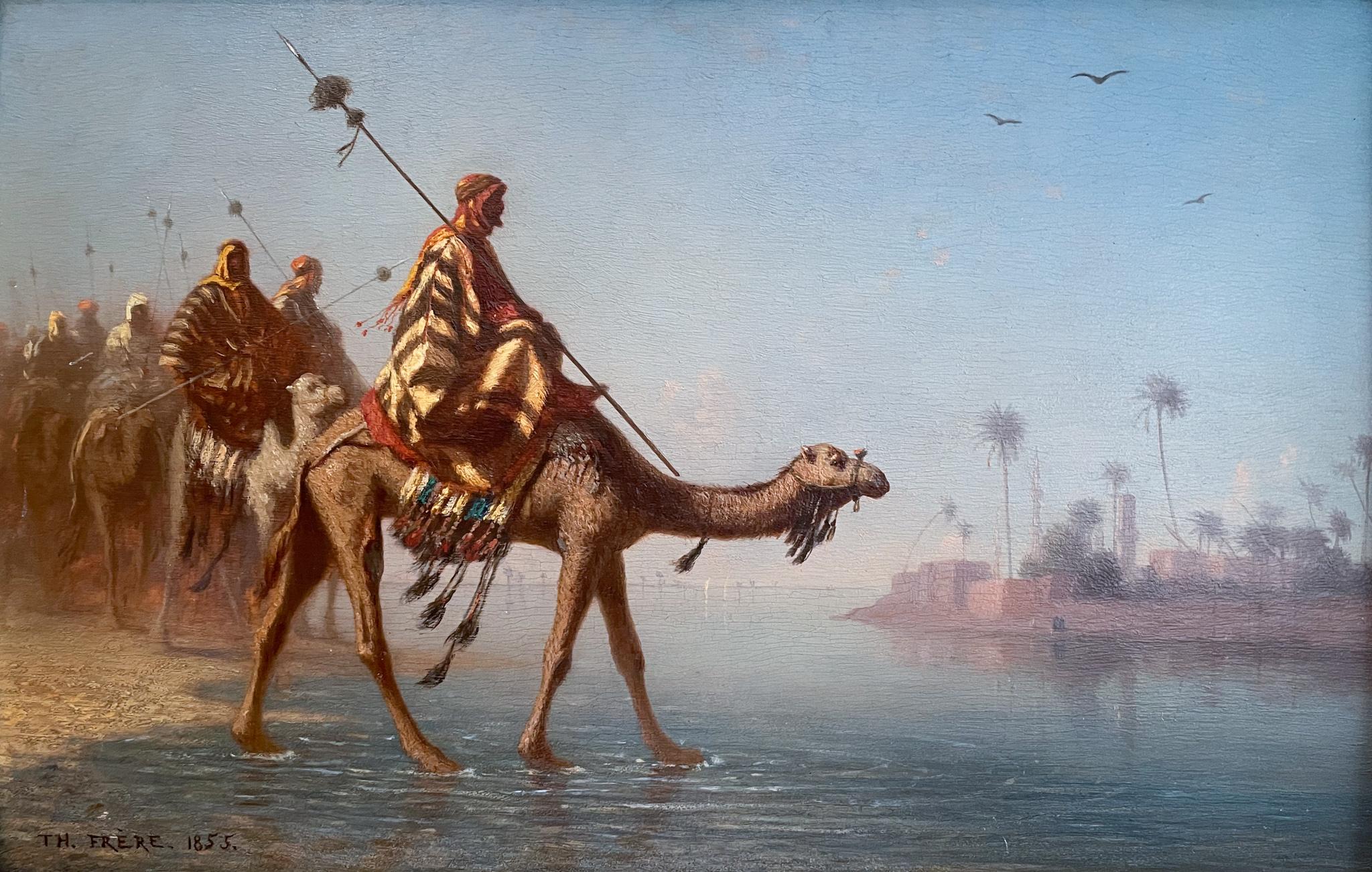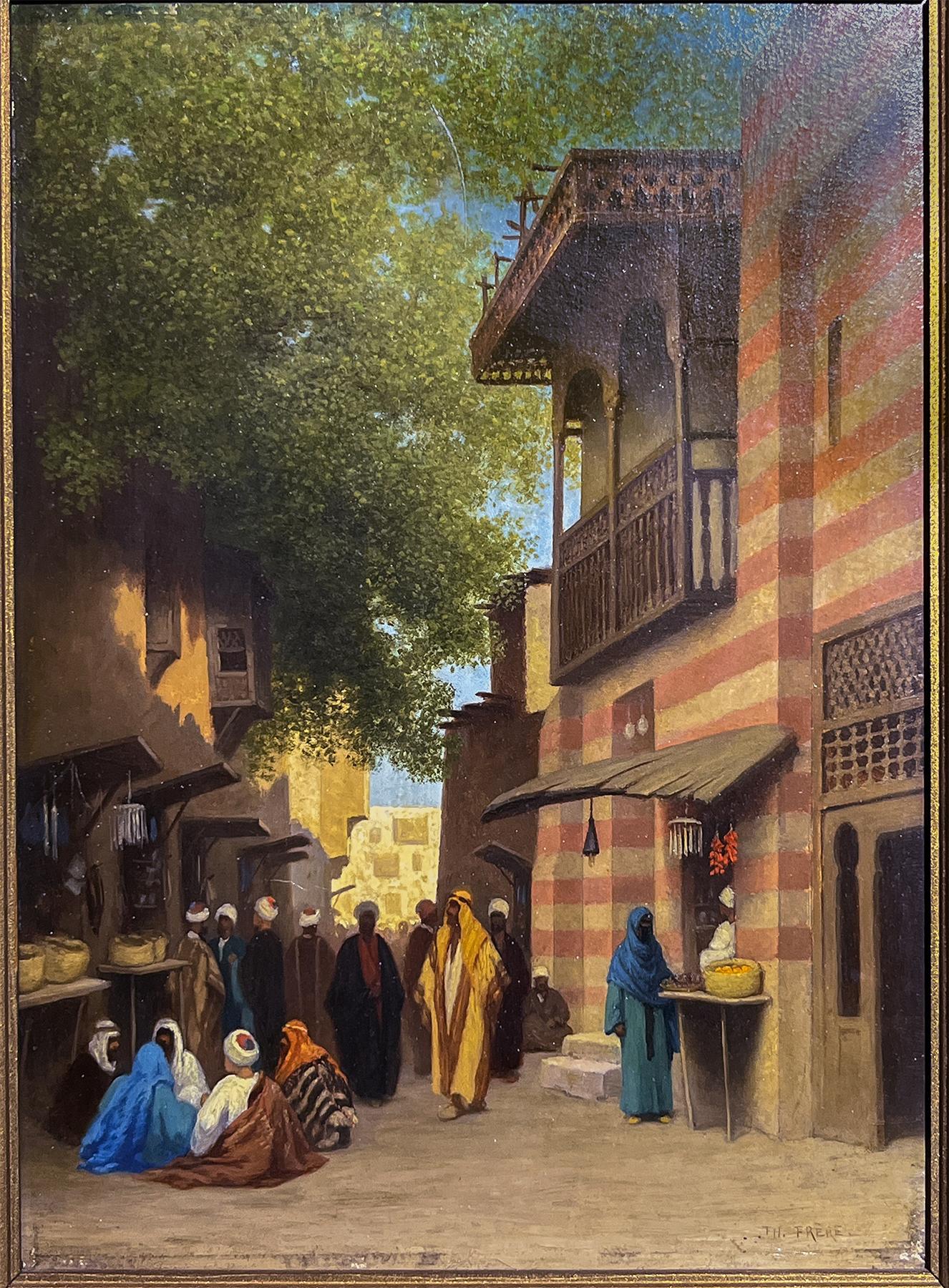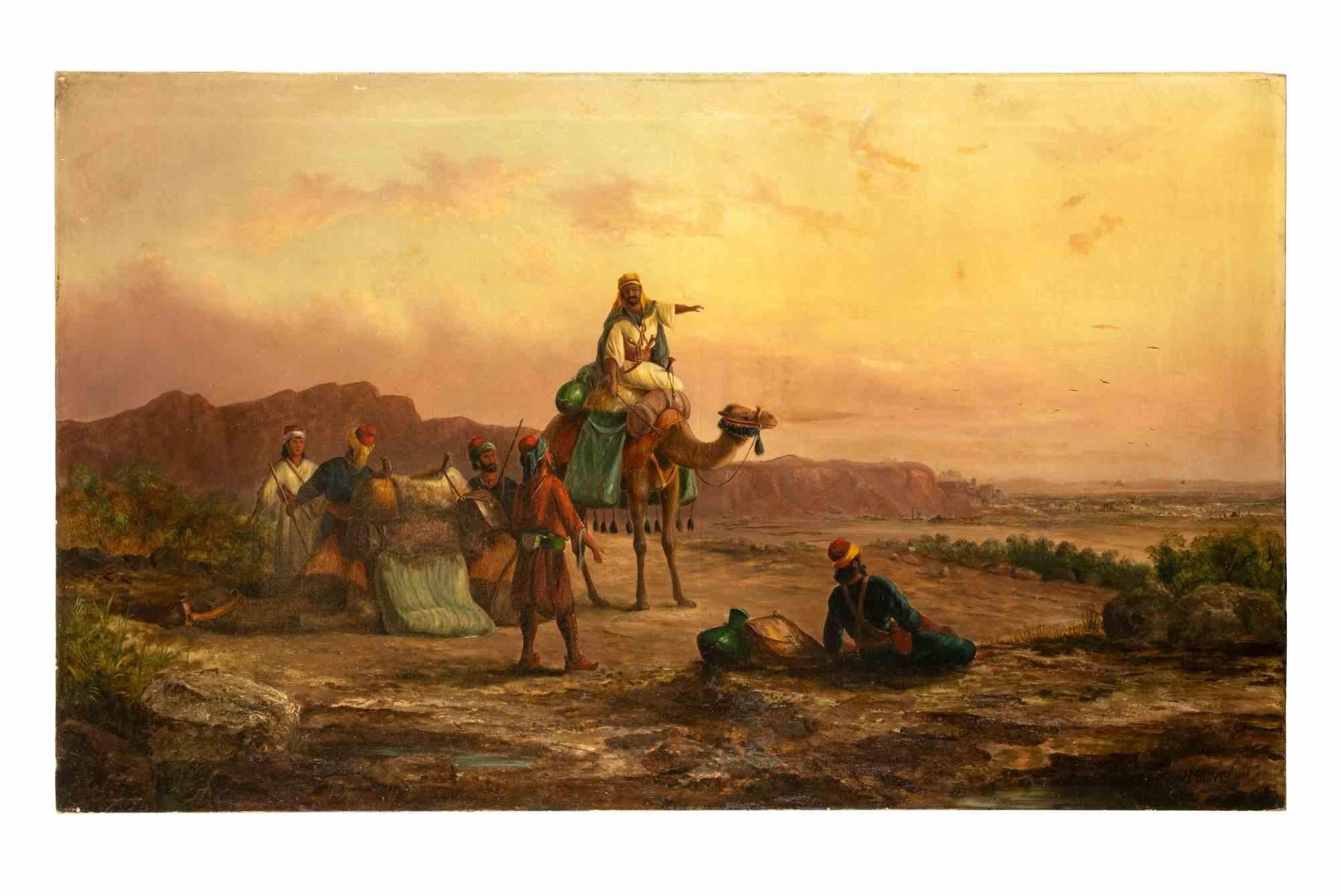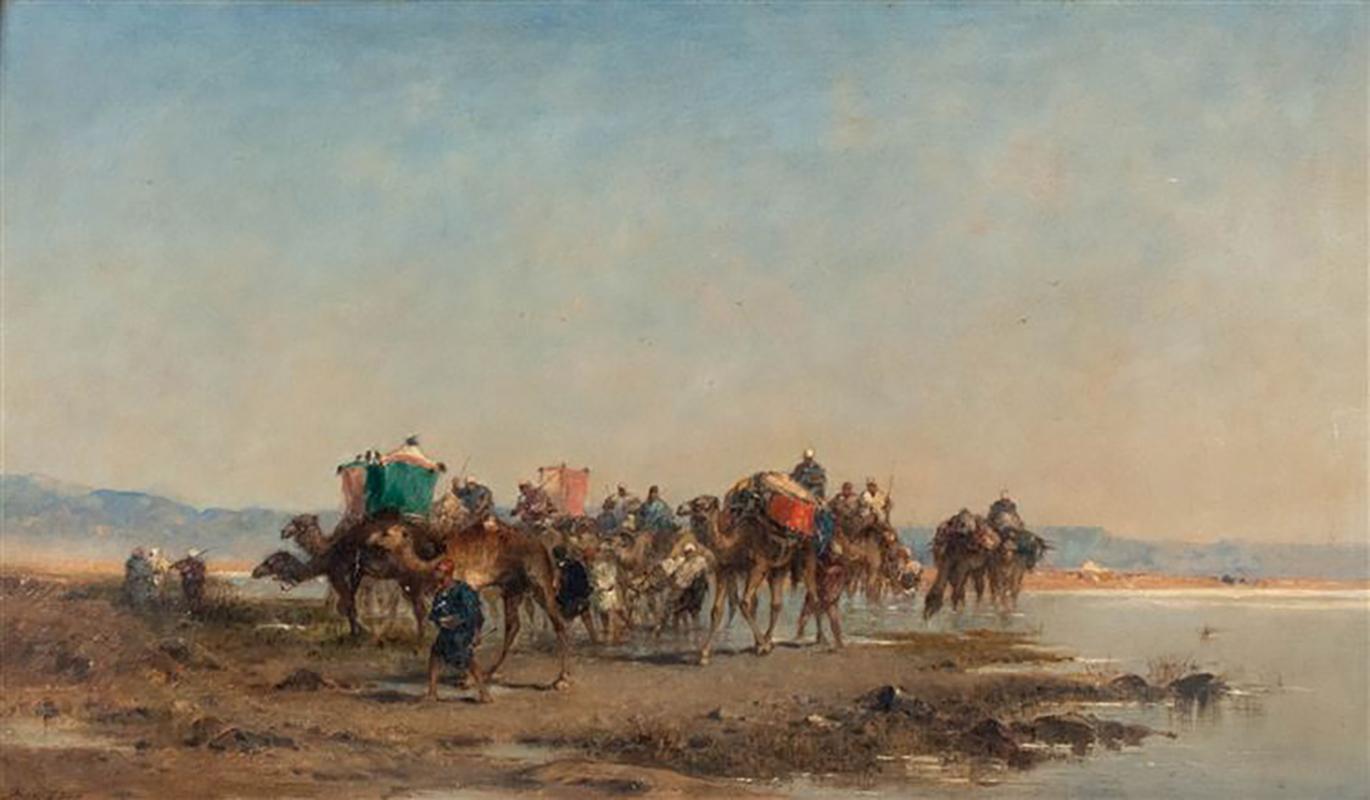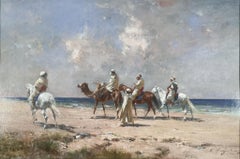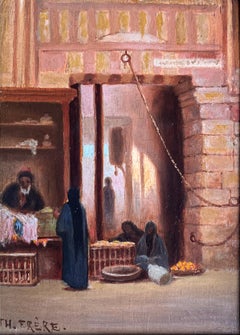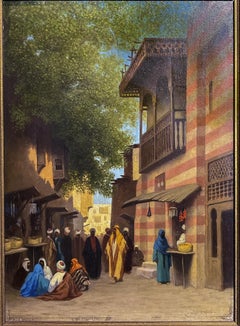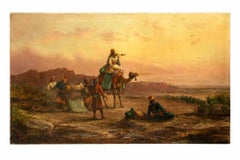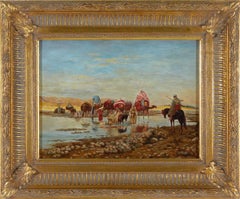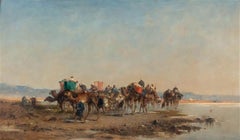Items Similar to Departure of the Caravan
Want more images or videos?
Request additional images or videos from the seller
1 of 11
Charles Théodore FrèreDeparture of the Caravan1855
1855
Price Upon Request
Price Upon Request
Price Upon Request
Price Upon Request
Price Upon Request
Price Upon Request
Price Upon Request
Price Upon Request
Price Upon Request
Price Upon Request
Shipping
Retrieving quote...The 1stDibs Promise:
Authenticity Guarantee,
Money-Back Guarantee,
24-Hour Cancellation
About the Item
Departure of the Caravan, 1834-1887, by Theodore Frere (1814-1888)
Oil on wood
10 x 16 inches unframed (25.4 x 40.64 cm)
18 ¾ x 24 ¾ inches framed (47.625 x 62.865 cm)
Signed on bottom right
Description:
Theodore Frere was a French Orientalist painter. Though he originally painted European landscapes, Frere became enamored with the “Eastern” world following his trip to Algeria and began to exclusively paint its exoticized scenes. Frere also traveled to Egypt, Greece, Turkey, and Syria, where he produced paintings that he exhibited in French salons starting in 1855. His Orientalist style drew the attention of the French public, and he received awards in 1848 and 1865 for his work.
In this oil painting, Frere depicts a subject matter common in his work: camels. He creates a palpable contrast between warm and cool tones: the yellow desert and camels are set against a vivid strip of blue sky. This segmentation of the canvas into warm and cool, sky and earth, evokes a separation of powers, with only the palm trees jutting into the space of the sky. The directionality of the camels, all facing left, signifies a collective action and movement that Frere does not divulge any information about.
The French Society of Orientalist Painters was founded in 1893, with Jean-Léon Gérôme as the honorary president.
The formation of the French Orientalist Painters Society changed the consciousness of practitioners towards the end of the 19th century, since artists could now see themselves as part of a distinct art movement. As an art movement, Orientalist painting is generally treated as one of the many branches of 19th-century academic art; however, many different styles of Orientalist art were in evidence. Art historians tend to identify two broad types of Orientalist artist: the realists who carefully painted what they observed such as Gustav Bauernfeint; and those who imagined Orientalist scenes without ever leaving the studio. French painters such as Eugène Delacroix (1798–1863) and Jean-Léon Gérôme (1824–1904) are widely regarded as the leading luminaries of the Orientalist movement.
- Creator:Charles Théodore Frère (1814 - 1888, French)
- Creation Year:1855
- Dimensions:Height: 10 in (25.4 cm)Width: 16 in (40.64 cm)
- Medium:
- Movement & Style:
- Period:
- Condition:
- Gallery Location:New York, NY
- Reference Number:1stDibs: LU163728852002
Charles Théodore Frère
Theodore Frere was a French Orientalist painter. Though he originally painted European landscapes, Frere became enamored with the “Eastern” world following his trip to Algeria and began to exclusively paint its exoticized scenes. Frere also traveled to Egypt, Greece, Turkey, and Syria, where he produced paintings that he exhibited in French salons starting in 1855. His Orientalist style drew the attention of the French public, and he received awards in 1848 and 1865 for his work.
About the Seller
5.0
Vetted Professional Seller
Every seller passes strict standards for authenticity and reliability
Established in 1948
1stDibs seller since 2021
9 sales on 1stDibs
Typical response time: 8 hours
- ShippingRetrieving quote...Shipping from: New York, NY
- Return Policy
Authenticity Guarantee
In the unlikely event there’s an issue with an item’s authenticity, contact us within 1 year for a full refund. DetailsMoney-Back Guarantee
If your item is not as described, is damaged in transit, or does not arrive, contact us within 7 days for a full refund. Details24-Hour Cancellation
You have a 24-hour grace period in which to reconsider your purchase, with no questions asked.Vetted Professional Sellers
Our world-class sellers must adhere to strict standards for service and quality, maintaining the integrity of our listings.Price-Match Guarantee
If you find that a seller listed the same item for a lower price elsewhere, we’ll match it.Trusted Global Delivery
Our best-in-class carrier network provides specialized shipping options worldwide, including custom delivery.More From This Seller
View AllThe Crossing
By Charles Théodore Frère
Located in New York, NY
The Crossing, 1855, by Theodore Frere (1814-1888)
Oil on wood panel
9 x 14 inches unframed (22.86 x 35.56 cm)
17 ¾ x 22 ½ inches framed (45.085 x 57.15 cm...
Category
19th Century Academic Landscape Paintings
Materials
Oil
Price Upon Request
In the Bazaar II
By Charles Théodore Frère
Located in New York, NY
In the Bazaar II, 1834-1855, by Theodore Frere (1814-1888)
Oil on wood
7 x 5 inches unframed (17.78 x 12.7 cm)
10 ⅝ x 9 inches framed (26.9875 x 22.86 cm)
Signed on lower right
Desc...
Category
19th Century Academic Figurative Paintings
Materials
Oil
Price Upon Request
Passage Along the Shore
By Victor Pierre Huguet
Located in New York, NY
Passage Along the Shore by Victor Pierre Huguet (1835-1902)
Oil on canvas
15 x 23 inches unframed (38.1 x 58.42 cm)
21 x 29 inches framed (53.34 x 73.66 cm)
Signed on bottom right
Description:
In this piece, Victor Pierre Huguet depicts five men traveling...
Category
19th Century Landscape Paintings
Materials
Oil
Price Upon Request
In the Bazaar I
By Charles Théodore Frère
Located in New York, NY
In the Bazaar I, 1834-1855, by Theodore Frere (1814-1888)
Oil on wood
7 x 5 inches unframed (17.78 x 12.7 cm)
10 ⅝ x 9 inches framed (26.9875 x 22.86 cm)
Signed on lower right
Descr...
Category
19th Century Academic Figurative Paintings
Materials
Oil
Price Upon Request
Visiting the Place of Pilgrimage
By Anna Richards Brewster
Located in New York, NY
Anna Richards Brewster
(American, 1870-1952)
Title: Visiting the Place of Pilgrimage
Medium: oil on canvas
Size: 17 x 25 inches / 26 x 34 inches framed
Markings: Signed lower left ...
Category
Late 19th Century Romantic Figurative Paintings
Materials
Canvas, Oil
The Great Pyramids of Giza
By Andrew McCallum
Located in New York, NY
Andrew Mac Callum
(British, 1821-1902)
Title: The Great Pyramids of Giza
Medium: Oil on canvas
Size: 36 in x 52 in
Markings: Signed lower right and dated 1878
Andrew MacCallum was ...
Category
Late 19th Century Realist Landscape Paintings
Materials
Canvas, Oil
You May Also Like
Charles Théodore Frère Orientalist Oil Painting
By Charles Théodore Frère
Located in New York, NY
Charles-Théodore Frère (French, 1814-1888)
"A Street Scene in Cairo"
In a carved wood frame painted to mimic tortoiseshell with a pale green velour liner.
Circa 1888
Signed
Oil...
Category
Late 19th Century Landscape Paintings
Materials
Oil, Wood Panel
Pilgrims Halting near Cairo - Oil Paint by Howard Hunt - Late 19th Century
By Richard Howard Hunt
Located in Roma, IT
Pilgrims halting near Cairo is an artwork realized by Howard Hunt.
Signed lower right.
At the back titled and signed.
127 x 76 cm.
Good conditions
Category
Late 19th Century Modern Figurative Paintings
Materials
Canvas, Oil
"Caravan Crossing a Ford" – Orientalist Oil Painting by R. Neilson (after Girard
Located in Jacksonville, FL
"Caravan Crossing a Ford" – Orientalist Oil Painting by R. Neilson (after Girardet)
Medium: Oil on panel
Dimensions (unframed): 12 in x 16 in (30.5 x 40.6 cm)
Framed Size: 23 in X 19...
Category
Early 20th Century Figurative Paintings
Materials
Oil
"CARAVANNE"
By Narcisse Berchere
Located in Jacksonville, FL
This painting vividly depicts a group of Arab travelers on camels stopping by a body of water to refresh and continue their journey. The beautiful brush strokes bring to life the ess...
Category
19th Century Paintings
Materials
Oil
$32,100
Antique Egyptian Landscape Oil Painting by Noël
By Jules Noel
Located in London, GB
Antique Egyptian landscape oil painting by Noël
French, 19th Century
Canvas: Height 28cm, width 38cm
Frame: Height 48cm, width 58cm, depth 6cm
This stunning Orientalist landscape is...
Category
19th Century Landscape Paintings
Materials
Canvas, Wood, Oil
Caravan by the sea
Located in Genève, GE
Work on canvas
Golden wooden frame
101 x 177 x 3.5 cm
Category
Early 20th Century Landscape Paintings
Materials
Oil
More Ways To Browse
19th Century Greece Painting
19th Century Turkish Paintings
Egyptian Camel
Camel Caravan
Vintage Army Radio
Antique Hay Cart
Antique Hay Trolley
Antique Orchard Painting
Ceylon Painting
Edouard Herve
Everglades Oil Painting
Francesca Romana
Jean Jacques Boimond
Lisa Lee
Mountain And Chalet Painting
Navy Oil Painting 18th Century
Occupied Japan China
Paul Lancaster
